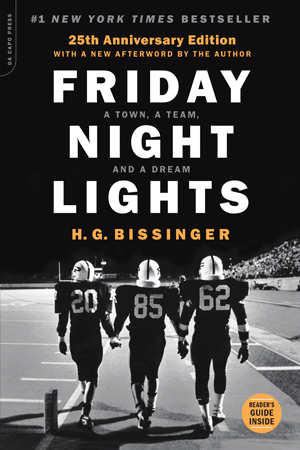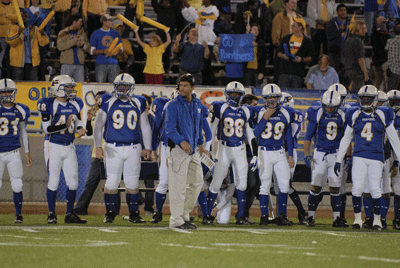Blame it on Jack Mildren. Or, perhaps, Dan Jenkins. Then, too, Larry McMurtry and Peter Bogdanovich could be culpable.
Without doubt, a cross-country drive in the mid-1980s finished what started with Mildren’s high school heroics, Jenkins’ account of those heroics and, separately, a novel by McMurtry and the film adaptation of the novel by Bogdanovich.
 |
An anniversary edition of the book features a new afterward by author Buzz Bissinger.
|
Mildren was an all-world small-town Texas quarterback (Abilene Cooper High) whose adolescent glory gained national attention when Jenkins profiled the prep passer’s blue-chip recruiting odyssey in Sports Illustrated in 1968. Three years later, McMurtry’s hard-bitten roman à clef, “The Last Picture Show,” became an Academy Award darling with eight nominations, including best picture, and two Oscars as directed by Bogdanovich.
The novel and movie continued themes from Jenkins’ story — small-town Texas, football, and coming of age.
Jenkins’ story and Bogdanovich’s movie floated through Buzz Bissinger’s head and were major influences during his adolescence. By 1986, in his early 30s and driving through the South and, eventually, Texas, Bissinger realized it was time to write about the ups and downs of a town living and dying on the shoulder pads of teenage boys playing football.
And that is how “Friday Night Lights” flickered to life. This month marks the 25th anniversary of Bissinger’s surprise best-seller, an account of the 1988 season of the Permian Panthers in Odessa, Texas.
The book spawned a movie in 2004, and, two years later, a network TV show that ran five seasons and cemented “Friday Night Lights” into pop culture. The show drew on the spirit of the book but used fictional characters, traded Odessa for a mythical small town and left the late-1980s behind in favor of a 21st century setting.
A person with knowledge of the various “Friday Night Lights” projects estimates they have generated a combined $100 million in revenue. Bissinger has made somewhere in the range of $3.5 million to date and still collects royalties on the 50,000 book copies sold each year.
Expect those numbers to keep growing. This month, Da Capo Press published an anniversary edition that includes a new afterword by Bissinger, who returned to Odessa to update the stories of some of the players, who are now middle-aged adults. “Friday Night Lights” has sold about 2 million copies, including 500,000 in the original hardcover published by Addison-Wesley, and has never gone out of print. Not bad for a first-time author writing about a team and a town most people had never heard of.
■ ■ ■
Bissinger took three weeks off from The Philadelphia Inquirer in 1986, joining a friend on a road trip that started in Boston and drifted into the South before heading west. The pace was leisurely. Throughout the tiny-dot towns of Alabama, Mississippi, Louisiana and Texas, the traveling companions wandered, glimpsing a forgotten America that, invariably, included at least one stadium serving as a shrine to the obsession of high school football.
Those stops got Bissinger thinking. If he ever was going to bite off a story about small-town isolation and the good and bad of sports as a cultural force, he knew he had to make his move soon. He returned to The Inquirer and won a Pulitzer for his role reporting on corruption in the Philadelphia court system, but the football idea kept gnawing at him.
Around the same time, he began talking to a former Andover prep school classmate, Michael Carlisle, about the idea of a book about high school football. Carlisle, then at the William Morris Agency, discussed where Bissinger should go to report the story, seeking opinions from coaches and other experts.
 |
Buzz Bissinger and his family
spent a year in Texas.
Photo by: DA CAPO PRESS
|
Discovery,
and soul searching,
in Odessa, Texas
In 1988, Buzz Bissinger went to Odessa, Texas, a bedraggled city of about 90,000 whose fortunes have long lived and died on two things: oil and football, and not necessarily in that order.
■ ■ ■
He ended up writing a book that stood out because of the details: the casual racism permeating the town, the team chartering a jet for a playoff game in El Paso — and because of the juxtaposition of a high school football empire being built while academics and school equality withered.
■ ■ ■
Photographer Robert Clark went to Odessa for a couple of weeks to shoot games, players, parents and fans, and he snapped a black-and-white image of three Permian Panthers players walking hand-in-hand on to the field that became the jacket cover. Said publishing executive George Gibson, “I remember when we first saw that jacket idea presented, everyone one of us thought, ‘That’s it. That’s perfect.’”
■ ■ ■
When he goes back to West Texas now, Bissinger causes much less of a stir. He ruefully laughs when people are surprised to learn a movie and television show were preceded by a book. Now 60, Bissinger is unsure when or whether he will tackle another book project.
Western Pennsylvania surfaced as a possibility, but Bissinger nixed the idea, eager to get away from Philadelphia and see a different part of the country. Georgia and other Southeastern states were mentioned, too. Texas, an obvious candidate from the start, emerged as a favorite. Bissinger wanted to take a look around before making his decision. In March 1988, he went to Odessa, a bedraggled city of about 90,000 whose fortunes have long lived and died on two things: oil and football, and not always in that order. He poked around, talking to the Permian head coach, Gary Gaines, asking whether Gaines would grant him access to get inside the culture of big-time high school football.
“I really got hooked when I saw the football stadium,” Bissinger said. “Which, at that point, was mind-boggling.”
In 1982, Odessa built Ratliff Stadium, a $5.6 million, 19,000-seat football home that, at the time, was extravagant enough to prompt billionaire businessman Ross Perot to decry the excess of such a public investment during an appearance on ABC’s “Nightline.” It stood as a monument to the importance of high school football in West Texas. And, of course, it became part of Bissinger’s story.
In July of 1988, Bissinger walked into the office of his editor, Gene Roberts, and quit. Two weeks later, Bissinger, his twin sons and the woman who would become his second wife moved to Odessa, where they lived for the next year.
From the start, Bissinger knew he had a good story. The Panthers were an established football power poised to win a state championship in 1988, and The Associated Press predicted Permian would take the title, too.
They didn’t, losing to Dallas Carter in the semifinals of the playoffs, a wrenching loss that made “Friday Night Lights” all the more poignant. Fourteen years after the book was published, when Bissinger’s cousin, Hollywood director Peter Berg, finally got the movie version off the ground, all Bissinger requested was that no fairy-tale championship ending be added. It wasn’t.
The book stood out because of the details — the casual racism permeating the town, the team chartering a jet for a playoff game in El Paso — and because of the juxtaposition of a high school football empire being built while academics and school equality withered.
Bissinger wrote about star running back Boobie Miles tearing up his knee in a preseason scrimmage and being discarded by coaches and fans alike. He followed the embattled coach, Gaines, and his family. After the Panthers lost their second regular-season game (the team finished 8-2 and advanced to the playoffs on a coin flip), “Gaines himself went home that Friday night at about two in the morning (and) found seven FOR SALE signs planted in his lawn,” Bissinger wrote.
Where it failed, in Bissinger’s mind, was as a cautionary tale, which he said was one of his motivations for writing the book. “It turned out not to be because sports is incredibly powerful and we still tend to [overemphasize] their importance at every level,” he said. “It’s just gotten worse at every level.”
A first draft started with a 200-page history of West Texas shale and the discovery of oil.
Bissinger had the goods and he had a photographer friend named Robert Clark come down for a couple of weeks to shoot games, players, parents and fans, and he just happened to snap a black-and-white image of three Permian players walking hand-in-hand onto the field that became the jacket cover.
“Our ambition for the book was very high to begin with,” said George Gibson, the Addison-Wesley marketing director at the time. “We thought it was worthy of that. The first thing that can galvanize the energy behind a book is getting that jacket image right. I remember when we first saw that jacket idea presented [of Clark’s photo of the players walking together], every one of us thought, ‘That’s it, that’s perfect.’ And it’s so rare when that happens.”
Addison-Wesley editorial director Jane Isay knew nothing of football, but she knew how to get the best out of the mercurial Bissinger. Author and editor recall their first hurdle the same way. A first draft started with a 200-page history of West Texas shale and the discovery of oil.
“I said, ‘Buzzy, at this rate this book is going to be longer than ‘The Rise and Fall of the Third Reich,’” Isay said, referring to the 1,200-page history of World War II-era Germany. Bissinger, 27 years removed from the conversation, recalled his editor’s next sentence without a pause. “[She said], ‘And Odessa is not Nazi Germany.’”
Using index cards, the author, editor and agent mapped out the structure of the book, interspersing major moments on the field with the primary characters (Miles, Gaines and others) and condensed versions of the social and political research Bissinger had done. Bissinger tried to write while he was still in Odessa, but struggled. By 1989, he had left Texas and moved to Milwaukee, where his wife was in medical school. With distance and his outline, it took about five months to finish the manuscript.
Clark’s soon-to-be iconic photo was a shoo-in for the jacket. Now all they needed was a title. Carlisle, the agent, sold the book proposal with the generic place-keeper of “Untitled Odessa, Texas Project.” Finding an actual title proved more vexing.
With the deadline bearing down, Carlisle, Isay and Bissinger went to lunch at the Union Square Café in New York.
“Give me some words and then we can play around with them,” Isay told Bissinger. His response? “On Friday nights, when the lights come up …”
Isay responded with a quick bit of editing that would become part of pop-culture history. “I said, ‘There’s your title: ‘Friday Night Lights.’”
■ ■ ■
Sometimes, to get some attention, a good story needs a good story. Or controversy.
The racism, the lopsided emphasis on football at the expense of academics, the oil-bust, hard-luck depiction of Odessa, all the warts Bissinger exposed, made him, for a while, anyway, persona non grata.
Gibson, the marketing director, remembered planning a trip to Odessa for Bissinger to promote the book. And then canceling it after threats of violence against Bissinger by angry residents who thought the book was unfairly harsh.
When Bissinger’s cousin, Hollywood director Peter Berg, finally got the movie version off the ground, all Bissinger requested was that no fairy-tale championship ending be added. It wasn’t.
A September 1990 story in The New York Times quoted the manager of the B. Dalton in Odessa saying of Bissinger, “I believe the author is wise to stay away, at least for the time being.” Combined with a “60 Minutes” feature and largely glowing reviews, “Friday Night Lights” became a hit.
Bissinger was 35 years old, in a Washington hotel room about to go on Larry King’s radio show, when he learned his debut had reached the best-seller list.
Much like the players he wrote about, Bissinger spent many years alternately embracing and resenting his glory days in Odessa. He wrote other books, broke other big stories and, in many ways, gained the clout to do pretty much whatever he felt like doing as a writer. But, all along, he knew he would never — could never — top “Friday Night Lights.”
He persuaded Berg, his cousin, to make the movie version, a sturdy effort heavy on small-town football. Bissinger said he knew from the start it was unrealistic to expect a mainstream Hollywood movie to delve into the social and racial politics the way his book did. Billy Bob Thornton played Gaines and Connie Britton his wife. Box-office sales topped $60 million.
 |
Kyle Chandler played Coach Erik Taylor in the television series based on the book.
Photo by: GETTY IMAGES
|
Two years later came the clincher for “Friday Night Lights” to extend its shelf life: Berg’s TV pilot, an inspired-by fictional adaptation snapped up by NBC.
Odessa became Dillon, Texas, and Gary Gaines morphed into Coach Erik Taylor, played by Kyle Chandler. Berg convinced Britton, an afterthought in the movie, she would have a significant role as Chandler’s wife, Tami. Shot on location in and around Austin, the show introduced a cast of young notables (Minka Kelly, Michael B. Jordan and Taylor Kitsch) who resonated with viewers.
Coach Taylor’s locker-room speeches, punctuated by Berg’s motto of “Clear eyes, full hearts, can’t lose,” became touchstones among a small but vocal and devoted audience. Critics loved the show. Drawing from the themes of the book, football became, at times, a backdrop for examinations of teen sex and pregnancy, drugs and alcohol, racial strife, school district politics, overzealous parents and boosters, and the happy but challenging marriage of the coach and his school-counselor wife, who juggle demanding jobs, parenting and exhaustion.
“There are certain shows that just burrow under your skin,” HitFix.com TV critic Alan Sepinwall said. “[It was a show that was great] at finding drama in everyday life.”
The drama meant plenty of people watched the show for football while others followed it for the way the characters faced real-life struggles. Bissinger said he admires the show and appreciates how the series expanded the book’s reach, but said he never watched on a regular basis. He had almost no involvement in the series and received about $2,500 per episode.
As beloved as the show was, it struggled to find an audience and after two seasons, it was left for dead.
Campaigns by fans and critics revived “Friday Night Lights” after an aborted, disappointing second season that was disrupted by a Hollywood writers’ strike. DirecTV rescued the show with a then-unusual co-production deal that gave the satellite service first-air rights before NBC showed episodes later in the year. The agreement kept the show alive for seasons three, four and five.
Today, cable networks Pivot and ESPN Classic air the series frequently, introducing a new generation to “Friday Night Lights.” Despite ending its run in 2011, the show retains cachet.
For Bissinger, making peace with the “Friday Night Lights” whirlwind has taken up much of the past 25 years. Time has healed wounds for him and for Odessa.
A person with knowledge of the various “Friday Night Lights” projects estimates they have generated a combined $100 million in revenue.
When he goes back to West Texas now, Bissinger causes much less of a stir. He ruefully laughs when people are surprised to learn the movie and the show were preceded by a book. Now 60, Bissinger is unsure when or whether he will tackle another book project.
He remains a big name in journalism. This summer, he wrote the widely discussed Vanity Fair cover story on Caitlyn Jenner. Bissinger brought not just his sports and journalism acumen to the Jenner story, but empathy, too.
Two years ago, Bissinger wrote a story for GQ that included his personal confessions of cross-dressing and binge shopping. By his calculation, Bissinger spent $600,000 on designer clothes over a three-year period before checking into rehab.
For many years, “I felt like, Jesus, I’m the literary equivalent of a high school quarterback. I peaked with my first book — it’s all downhill from there. But as I put it into perspective, I’m incredibly lucky for [‘Friday Night Lights’] to have success. I am much more comfortable with it.”
Clear eyes, full hearts … You know the rest.
Erik Spanberg writes for the Charlotte Business Journal, an affiliated publication.






